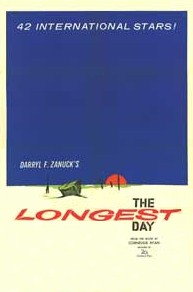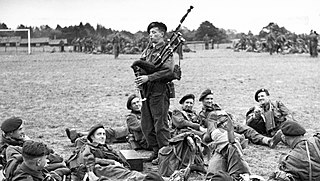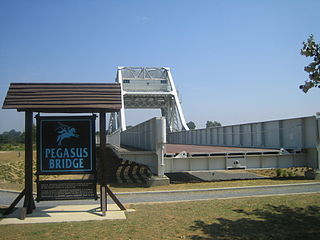
Pegasus Bridge, originally called the Bénouville Bridge after the neighbouring village, is a road crossing over the Caen Canal, between Caen and Ouistreham in Normandy. The original bridge, built in 1934, is now a war memorial and is the centrepiece of the Memorial Pegasus museum at nearby Ranville. It was replaced in 1994 by a modern design which, like the old one, is a bascule bridge.

Bénouville is a commune in the Calvados department in the Normandy region in northwestern France.

Ouistreham is a commune in the Calvados department in Normandy region in northwestern France.

The Longest Day is a 1962 American epic war film, shot in black and white and based on Cornelius Ryan's 1959 non-fiction book of the same name about the D-Day landings at Normandy on June 6, 1944. Producer Darryl F. Zanuck paid Ryan $175,000 for the film rights to the book. The screenplay was by Ryan, with additional material written by Romain Gary, James Jones, David Pursall, and Jack Seddon. The film was directed by Ken Annakin, Andrew Marton, and Bernhard Wicki.
A coup de main is a swift attack that relies on speed and surprise to accomplish its objectives in a single blow.

Major Reginald John Howard DSO was a British Army officer who led a glider-borne assault that captured the Caen canal and Orne river bridges on 6 June 1944, as part of the D-Day landings during the Second World War. These bridges spanned the Caen Canal and the adjacent River Orne, and were vitally important to the success of the D-Day landings. Since the war, the bridge over the canal has become known as "Pegasus Bridge," a tribute to the men who captured it. The bridge over the River Orne later became known as Horsa Bridge after the Horsa gliders that carried troops to the bridges.

Lieutenant Herbert Denham Brotheridge was a British Army officer who served with the 2nd Battalion, Oxfordshire and Buckinghamshire Light Infantry during the Second World War. He is often considered to be the first Allied soldier to be killed in action on D-Day, 6 June 1944. He was killed during Operation Tonga: the British airborne landings which secured the left flank of the invasion area before the main assault on the Normandy beaches began.
Staff Sergeant James Harley Wallwork DFM was a British soldier and a member of the Glider Pilot Regiment who achieved notability as the pilot of the first Horsa glider to land at Pegasus Bridge in the early hours of D-Day, 6 June 1944, during the Second World War. This achievement was described as "the greatest feat of flying of the second world war" by Air Chief Marshal Sir Trafford Leigh-Mallory. Although most noted for his part in the Battle of Normandy, Wallwork flew gliders in every major British airborne operation of the Second World War. These also included the Sicily landings, Arnhem and the Rhine Crossings. In later life he lived in Vancouver.

The Château de Bénouville is a building in Bénouville, Normandy, near Caen. It was designed in 1769 by architect Claude Nicolas Ledoux and built in 1770-74 and 1776-80 at the request of Hyppolite-François Sanguin, marquis of Livry (1715–1789) and his marquise Thérèse Bonne Gillain de Bénouville, heiress of the property. The interior was under construction from 1778 to 1780 under the direction of Jean-François-Étienne Gilet, the architect of Caen. In 1792, it was purchased from the widowed marquise by a fermier général who was guillotined in 1794. His daughter inherited the property which remained in that family until 1927. It then became the property of the general council of Calvados which turned it into a maternity hospital. In 1980, it was rehabilitated and restored, opening its doors to the public in 1990.

William Millin, commonly known as Piper Bill, was a Canadian musician who played bagpipes, and was personal piper to Simon Fraser, 15th Lord Lovat, commander of the British 1 Special Service Brigade at D-Day.

Bénouville is a commune in the Seine-Maritime department in the Normandy region in northern France.
Colonel Henry John Sweeney MC, known as Tod Sweeney, was an officer of the British Army. During the Second World War he was a platoon commander in the coup de main operation, by gliderborne troops of the 2nd Battalion, Oxfordshire and Buckinghamshire Light Infantry, on D-Day, 6 June 1944, tasked to seize Horsa Bridge and Pegasus Bridge before the main assault on the Normandy beaches began. The following day he was awarded the Military Cross for rescuing a wounded member of his platoon while under heavy fire near Escoville. Sweeney commanded the 1st Green Jackets at Penang from April 1962 to January 1964; during the Brunei Revolt and Indonesia-Malaysia confrontation.
Colonel David James Wood MBE was the last surviving officer of the coup de main operation carried out by glider borne troops of the 2nd Oxfordshire and Buckinghamshire Light Infantry, on D Day, 6 June 1944, tasked with capturing Pegasus Bridge and Horsa Bridge before the main assault on the Normandy beaches began.
Horsa Bridge, also known as Ranville Bridge, over the Orne river, was, along with Pegasus Bridge, captured during Operation Tonga by gliderborne troops of the 2nd Oxfordshire and Buckinghamshire Light Infantry in a coup de main operation in the opening minutes of D-Day, 6 June 1944. The seizing of both bridges was considered to be critical to securing the eastern flank of the Normandy landings area, preventing German armour from reaching the British 3rd Infantry Division which was due to start landing on Sword at 07.25hrs. Horsa Bridge, a road bridge, was over 400 yards east of Pegasus Bridge towards the village of Ranville.

The capture of the Caen canal and Orne river bridges was an operation by airborne forces of the British Army that took place in the early hours of 6 June 1944 as part of the Normandy landings of the Second World War. The objective was to capture intact two road bridges in Normandy across the River Orne and the Caen canal, providing the only exit eastwards for British forces from their landing on Sword Beach. Intelligence reports said both bridges were heavily defended by the Germans and wired for demolition. Once captured, the bridges had to be held against any counter-attack, until the assault force was relieved by commandos and other infantry advancing from the landing beach.
Major Richard Arthur Amyas Smith was a British Army officer who served during the Second World War. He was awarded a Military Cross for gallantry and leadership whilst serving as a platoon commander in the gliderborne 2nd Oxfordshire and Buckinghamshire Light Infantry coup de main operation; tasked to capture Pegasus Bridge and Horsa Bridge during the opening minutes of D-Day, 6 June 1944. The capture of both bridges was considered to be critical to securing the left flank of the Normandy landings area.
Major Dennis Barraclough Fox MBE (1920-1993) was an officer of the British Army. During the Second World War he led the first platoon to land at Horsa Bridge in the gliderborne 2nd Battalion, Oxfordshire and Buckinghamshire Light Infantry coup de main operation, during the opening minutes of D-Day, 6 June 1944, which captured the Caen canal and Orne river bridges. These bridges were considered to be critical to securing the eastern flank of the Normandy landings area.

Memorial Pegasus at Ranville in Lower Normandy is a museum and memorial to the 6th Airborne Division in the Normandy landings and particular the capture of the Caen canal and Orne river bridges.

Pegasus Bridge is a turn-based strategy video game developed and published by Personal Software Services. It was released exclusively in the United Kingdom for the ZX Spectrum, Amstrad CPC and Commodore 64 in 1987. It is the ninth installment of the Strategic Wargames series. The game is set during the landings in Normandy on D-Day in the Second World War and revolves around the British 6th Airborne Division's attempts to secure a bridge over the Caen Canal.

The Café Gondrée is a small coffeehouse in the French community of Bénouville. The cafe is located on the west bank of the Caen Canal, at the northwest end of the Bénouville Bridge, now commonly referred to as the Pegasus Bridge. The building was the site of first combat during the D-Day invasion, and is best known for its role commemorating those events.











